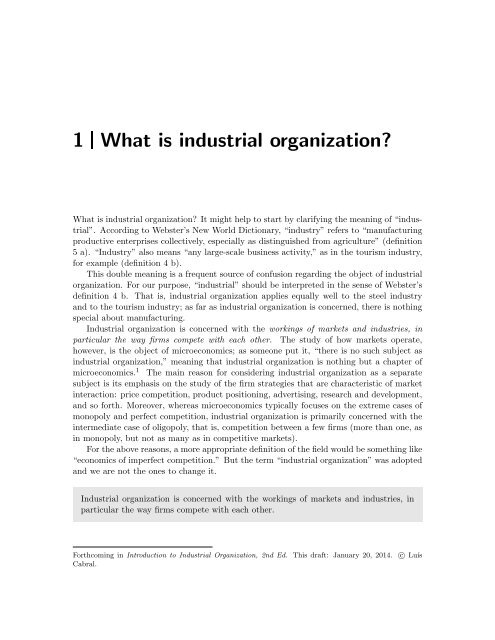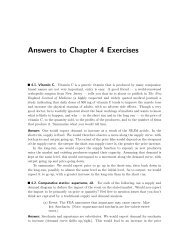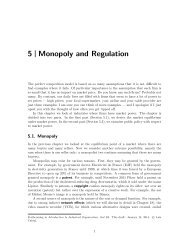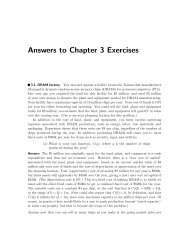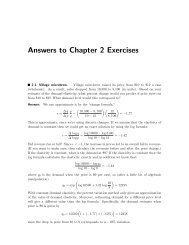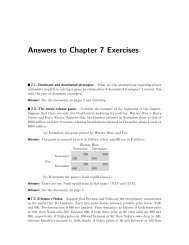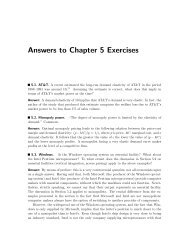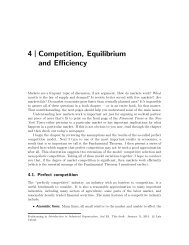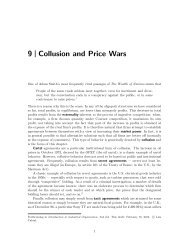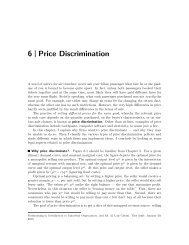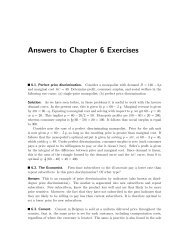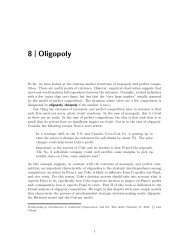1. Introduction - Luiscabral.net
1. Introduction - Luiscabral.net
1. Introduction - Luiscabral.net
You also want an ePaper? Increase the reach of your titles
YUMPU automatically turns print PDFs into web optimized ePapers that Google loves.
1 What is industrial organization?<br />
What is industrial organization? It might help to start by clarifying the meaning of “industrial”.<br />
According to Webster’s New World Dictionary, “industry” refers to “manufacturing<br />
productive enterprises collectively, especially as distinguished from agriculture” (definition<br />
5 a). “Industry” also means “any large-scale business activity,” as in the tourism industry,<br />
for example (definition 4 b).<br />
This double meaning is a frequent source of confusion regarding the object of industrial<br />
organization. For our purpose, “industrial” should be interpreted in the sense of Webster’s<br />
definition 4 b. That is, industrial organization applies equally well to the steel industry<br />
and to the tourism industry; as far as industrial organization is concerned, there is nothing<br />
special about manufacturing.<br />
Industrial organization is concerned with the workings of markets and industries, in<br />
particular the way firms compete with each other. The study of how markets operate,<br />
however, is the object of microeconomics; as someone put it, “there is no such subject as<br />
industrial organization,” meaning that industrial organization is nothing but a chapter of<br />
microeconomics. 1 The main reason for considering industrial organization as a separate<br />
subject is its emphasis on the study of the firm strategies that are characteristic of market<br />
interaction: price competition, product positioning, advertising, research and development,<br />
and so forth. Moreover, whereas microeconomics typically focuses on the extreme cases of<br />
monopoly and perfect competition, industrial organization is primarily concerned with the<br />
intermediate case of oligopoly, that is, competition between a few firms (more than one, as<br />
in monopoly, but not as many as in competitive markets).<br />
For the above reasons, a more appropriate definition of the field would be something like<br />
“economics of imperfect competition.” But the term “industrial organization” was adopted<br />
and we are not the ones to change it.<br />
Industrial organization is concerned with the workings of markets and industries, in<br />
particular the way firms compete with each other.<br />
Forthcoming in <strong>Introduction</strong> to Industrial Organization, 2nd Ed. This draft: January 20, 2014.<br />
Cabral.<br />
c○ Luís
<strong>1.</strong><strong>1.</strong> An example<br />
Examples are often better than definitions. In this section, I look into the market for antiulcer,<br />
anti-heartburn drugs, a case that touches on a number of issues of interest to industrial<br />
organization. The case thus provides a useful introduction to the next section, where I look<br />
more systematically at the central questions addressed by industrial organization.<br />
Until the late 1970s, there was no effective drug to treat ulcers; severe cases required<br />
surgery. Then a research project at Smith, Kline and French culminated with the discovery<br />
of cimetidine, a wonder drug sold under the brand name Tagamet. The production cost of<br />
Tagamet was rather small compared to the price for which it was sold. In cases like this,<br />
the huge gap between price and cost is bound to raise a variety of issues. For example, it<br />
may seem unfair that many suffering patients be deprived of a cheap-to-produce drug simply<br />
because price is so high. Then again, without revenues from drugs such as Tagamet it seems<br />
impossible for firms like Smith, Kline and French to continue churning out blockbuster drugs.<br />
The fact is that the market for anti-ulcer drugs was enormous. Although Smith, Kline<br />
and French had a patent for cimetidine (valid until 1997), this did not stop other pharmaceutical<br />
giants from coming up with alternative products: Zantac, introduced by Glaxo in<br />
1983; Pepcid, introduced by Merck in 1986; and Axid, introduced by Eli Lilly in 1988.<br />
For many industry experts, Zantac, Pepcid and Axid were little more than a copycats<br />
(also known as “me too” drugs). In fact, reviews of clinical trials indicated that there was<br />
little difference in the success rates of the various drugs; in other words, one drug could<br />
easily substitute for any of the other ones. Why wasn’t then price competition more intense?<br />
The answer is: advertising.<br />
BELLYACHE BATTLES. We knew that the battle for your bellyaches would be<br />
big, but we had no idea it would be so bloody. Hundreds of millions of dollars<br />
are being poured into advertising designed to establish brand loyalty for either<br />
Tagamet HB or Pepcid AC. Zantac 75 will join the fray shortly.<br />
These drugs were blockbusters as prescription ulcer treatments; now that they<br />
are available over the counter for heartburn their manufacturers have really<br />
taken off the gloves. 2<br />
Nor is this specific to anti-ulcer and heartburn drugs. Overall, the advertising budgets<br />
of large pharmaceutical companies are of the same order of magnitude as their research<br />
budgets. What matters is not just the product’s worth, but also what consumers — and<br />
doctors, who frequently act as agents for the final consumer — think the product is worth.<br />
Glaxo emerged as the winner of this advertising battle. It “set out to make heartburn<br />
into an acute and chronic ‘disorder’ that came with serious consequences if not treated twice<br />
daily with the company’s two-dollar pill.” 3 By 1988, Zantac had overtaken Tagamet as the<br />
world’s best selling drug.<br />
Zantac’s patent expired in the late 1990s, paving the way for competition by generics. A<br />
generic is a chemically equivalent drug that is sold under the chemical name (Ranitidine, in<br />
the case of Zantac) rather than under the brand name. Notwithstanding numerous claims<br />
that generic Zantac has the same effect as branded Zantac, the latter still manages to<br />
command a large market share while selling at a much higher price. In July 1999, shortly<br />
after patent expiry, discount drug seller RxUSA was quoting a 30-tablet box of 300 mg<br />
Zantac at $85.95. For a little more than that, $95, one could buy a 250-tablet box of 300<br />
2
mg generic Zantac Ranitidine—that is, for 7.5 times less per tablet. More than a decade<br />
after patent expiry, price differences remain significant: In January 2014, 150 mg Zantac<br />
cost almost 40 cents per tablet, whereas the corresponding generic sold for about 8 cents.<br />
Another testament to the enduring value of a strong brand is that, in 2006, Boehringer<br />
Ingelheim paid more than $500 million dollars for the U.S. rights to Zantac.<br />
At the time of Zantac’s launch, Glaxo was an independent company. Since then, it first<br />
merged with Wellcome to form GlaxoWellcome, then with SmithKline (which in turn resulted<br />
from a then recent merger) to form GlaxoSmithKline. (It’s a good thing the merged<br />
firms did not keep all of their names, else we would have to spell GlaxoWellcomeSmithKlineFrench!)<br />
Frequently, these mergers are heralded as the sources of important synergies.<br />
For example, where GlaxoWellcome was formed, the merging parties argued that the combination<br />
of Wellcome’s AZT and Glaxo’s 3TC worked better against AIDS than either drug<br />
alone. 4 Critics, however, see it primarily as a source of greater market power: if you cannot<br />
win the competitor, then buy the competitor.<br />
<strong>1.</strong>2. Central questions<br />
The example in the previous section illustrates several issues that industrial organization<br />
is concerned with (see below, in italics): for decades, GlaxoWellcome was a firm that commanded<br />
a significant degree of market power in the anti-ulcer and heartburn therapeutical<br />
segment (the relevant market definition). GlaxoWellcome, which resulted from the merger<br />
of Glaxo and Wellcome, established its position by means of a clever R&D strategy that<br />
allowed it to enter an industry already dominated by SmithKline; and by means of an<br />
aggressive marketing strategy that increased its market share. For a period of time, Zantac’s<br />
position was protected by patent rights. This is no longer the case, meaning that<br />
differentiating the product with respect to the incoming rivals (generics producers) is now a<br />
priority.<br />
In this section, I attempt to formulate the object of industrial organization in a more<br />
systematic way. One can say that the goal of industrial organization is to address the<br />
following four questions: (a) Do firms have market power? (b) How do firms acquire and<br />
maintain market power? (c) What are the implications of market power? (d) What role is<br />
there for public policy as regards market power?<br />
Since all of these questions revolve around the notion of market power, it may be useful<br />
to make this notion more precise. Market power may be defined as the ability to set prices<br />
above cost, specifically above incremental or marginal cost, that is, the cost of producing<br />
one extra unit. a So, for example, if GlaxoWellcome spends $10 to produce a box of Zantac<br />
and sells it for $50, then we say that it commands a substantial degree of market power.<br />
Now for the questions.<br />
Is there market power? Understandably, this is an important question, in fact, a<br />
crucial one. If there is no market power, then there is little point in the study of industrial<br />
organization.<br />
Over the years, many empirical studies have attempted to measure the extent of market<br />
power. Assuming that costs are proportional to output, a good approximation to the extent<br />
a. A rigorous definition of marginal cost and other cost concepts is given in Chapter 3. If costs are<br />
proportional to output, then marginal cost is equal to unit cost.<br />
3
of market power can be obtained from data on prices, output and profit rates. b One study<br />
along these lines found that the extent of market power in the American economy is very<br />
low, a conclusion that follows from observing relatively low profit rates. 5 This finding is<br />
consistent with one of the central te<strong>net</strong>s of the Chicago school: as long as there is free<br />
entry into each industry, the extent of market power is never significant. If a firm were to<br />
persistently set prices above cost, a new firm would find it profitable to enter the market<br />
and undercut the incumbent. Therefore, market power cannot persist, the argument goes. c<br />
Not every economist agrees with this view, either at a theoretical or at an empirical level.<br />
From an empirical point of view, an alternative approximation to the value of marginal cost<br />
is obtained by dividing the increase in cost from year t to year t + 1 by the increase in<br />
output in the same period. Based on this approach, a study estimates that prices may be<br />
as much as three times larger than marginal cost. 7<br />
Evidence from particular industries also suggests that the extent of market power may<br />
be significant. Take, for example, the U.S. airline industry. An 1996 U.S. government report<br />
analyzed average fares in 43 large airports. In ten of these airports, one or a few airlines<br />
hold a tight control over takeoff and landing slots. The report found that, on average,<br />
fliers were paying 31% more at these airports than at the remaining 33 airports. 8 In other<br />
words, the report provides evidence that airlines which manage to control the critical asset<br />
of airport access hold a significant degree of market power.<br />
Further examples could be supplied. These would not necessarily be representative of<br />
what takes place in every market. To be sure, there is a large number of industries where<br />
firms hold little or no market power (cf Chapter 4). The point is that there are some<br />
industries where market power exists to a significant extent.<br />
How do firms acquire and maintain market power? Market power translates into<br />
higher profits. Creating and maintaining market power is therefore an important part of a<br />
firm’s value-maximization strategy.<br />
How do firms acquire market power? One possibility is to be legally protected from<br />
competition, so that high prices can be set without new competitors entering the market.<br />
For example, in the 1960s Xerox developed the technology of plain-paper photocopying, and<br />
patented it. Given the legal protection provided by Xerox’s patents, it could raise prices to<br />
a significant level without attracting competition (cf Chapter 17).<br />
Firm strategy may also play an important role in establishing market power. Take,<br />
for example, the case of the British Sky Broadcasting Group (BSkyB), a leading firm in<br />
the British digital TV market (formed in 1990 by the merger of Sky Television and British<br />
Satellite Broadcasting). Attempting to preempt the competition, in 1999 BSkyB introduced<br />
an aggressive package that included a free set-top decoder box, free Inter<strong>net</strong> access and a<br />
40% discount on telephone charges. 9 The plan, which was largely successful, was to create<br />
an early lead in installed base of subscribers, an early lead that would hopefully become<br />
permanent.<br />
Creating market power is only one part of the story. A successful firm must also be able<br />
to maintain market power. Patents expire. Imitation takes place. Protected industries are<br />
b. The profit rate is given by revenues minus cost divided by costs: r = (R − C)/C. If costs are<br />
proportional to output, then costs are given by unit cost times output, UC ·Q (Q is output), whereas<br />
revenues are given by R = P · Q (P is price). It follows that r = (P − UC )/UC , so r is a good<br />
measure of the gap between price and unit cost (which in this case is also equal to marginal cost).<br />
c. The theory of contestable markets formalizes this argument. 6<br />
4
deregulated. What can incumbents do in order to maintain their position? A recent example<br />
is given by the airline industry. In 1998, Japan deregulated its airline industry. Skymark<br />
Airlines and Air Do entered a market which, for 35 years, was dominated by incumbents<br />
Japan Airlines (JAL) and All Nippon Airlines (ANA). The latter responded to entry by<br />
engaging in an aggressive price war — to the delight of consumers. But the incumbents’<br />
response goes beyond this. ANA and JAL carry out maintenance of the upstarts’ planes,<br />
for there are no independent servicing companies in Japan. There was a fear that ANA and<br />
JAL would refuse to service additional planes introduced by Skymark and Air Do. And<br />
that, eventually, the industry would return to its old ways — high fares and high profits. 10<br />
Fortunately for consumers, Skymark and Air Do continue operations. As of 2013, Air Do<br />
had a fleet of 10 planes, whereas Skymark operated 31 planes. In fact, new competition<br />
arrived in recent years, so much so that Skymark decided to refocus from popular routes to<br />
more exclusive ones.<br />
Across the ocean, U.S. American Airlines managed to drive out various competitors who<br />
attempted to enter into its Dallas/Forth Worth hub: Vanguard, Sun Jet, Western Pacific.<br />
Fares on the route between Dallas and Kansas City, for example, fell from $108 to $80<br />
when Vanguard entered the market. After Vanguard exited, American gradually raised<br />
fares up to $147 in 1996. 11 Joel Klein, then head of the antitrust division at the Justice<br />
Department, said that American’s strategy achieved more than just driving current rivals<br />
out of the market — it also sent a clear signal to potential future entrants: “A sophisticated<br />
economist compared it to choosing between two fields with ‘no trespassing’ signs. One has<br />
two dead bodies in it, the other has no dead bodies in it. Which field would you feel ready<br />
to trespass?” Reputation for toughness is a reliable means of maintaining a position of<br />
market power.<br />
In different chapters of this text, especially in Chapters 12 to 18, we will examine a large<br />
set of strategies that firms may deploy in order to create and maintain their market power.<br />
What are the implications of market power? From the firm’s point of view, market<br />
power implies greater profits and greater firm value. From a social welfare point of view—or<br />
from a policy maker point of view, if we believe policy makers pursue the collective good—,<br />
the implications are more complicated.<br />
The first-order effect of a high price is a transfer from consumers to firms: d for each<br />
extra dollar in price, each buyer is transfering one extra dollar to the seller. If regulators<br />
put a greater weight on consumer welfare than on profits, then this transfer should be seen<br />
as a negative outcome. In fact, anti-trust and competition policies are to a great extent<br />
motivated by the goal of protecting consumers from these transfers (see the next question).<br />
But, in addition to a transfer effect, a high price also implies an inefficient allocation<br />
of resources. High airfares, for example, mean that there are potential fliers who refrain<br />
from buying tickets even though the cost of carrying them as passengers would be very low.<br />
From a social point of view, it would be efficient to fly many of these potential travelers:<br />
although the value they derive from flying is lower than the price (hence they don’t fly),<br />
that value is greater than the cost of flying (which is much lower than price). The loss<br />
that results from the absence of these sales is the allocative inefficiency implied by market<br />
power. e<br />
d. By “first-order” we mean the effect that is quantitatively most significant.<br />
e. A rigorous definition of this concept is given in Chapter 5.<br />
5
“The best of all monopoly profits is the quiet life:” 12 a monopolist does not need<br />
to be bothered with competition. More generally, firms with greater market power have<br />
less incentives to be cost efficient, one may argue. For example, for many years European<br />
airlines were known to be less efficient than North-American airlines. To a great extent, this<br />
efficiency gap resulted from the more intense competition in the North-American market. f<br />
In other words, market power implies a second type of inefficiency: productive inefficiency,<br />
which we define as the increase in cost that results from market power. g<br />
When market power is artificially maintained by government intervention, a third type of<br />
inefficiency may result: rent seeking. By rent seeking we mean unproductive the resources<br />
spent by firms in attempting to influence policymakers. Consider, for example, the following<br />
1999 news article regarding AT&T’s effort to maintain its position in the cable television<br />
market:<br />
This summer, AT&T Corp. faced the specter of cities around the country requiring<br />
it to open its cable television lines to rival Inter<strong>net</strong> companies . . . The<br />
threat never really materialized. Why not? It depends on whom you ask.<br />
AT&T attributes its success to its ability to explain the issues to local officials<br />
. . . [Others have a different opinion:] “It comes down to bribery or threats,”<br />
says Greg Simon, co-director of Open<strong>net</strong> Coaltion, a group of companies that<br />
has launched its own lobbying effort to promote open access. 13<br />
Another example of large amounts of resources spent in attempting to influence decisionmakers<br />
is the U.S. v Microsoft case. Netscape, Sun Microsystems, and Microsoft itself would<br />
not have spent the vast amounts they did spend if the operating system industry were not<br />
as profitable as it is; thus the idea that rent seeking is a consequence of market power.<br />
To summarize, the above paragraphs support the view that market power, good as<br />
it might be for firms, is bad for society. First, it makes firms richer at the expense of<br />
consumers. Second, it decreases economic efficiency (allocative and productive efficiency).<br />
Third, it induces firms to waste resources in order to achieve and maintain market power.<br />
However, from a dynamic point of view, an argument can be made in favor of market power:<br />
As soon as we go into the details and inquire into the individual items in which<br />
progress was most conspicuous, the trail leads not to the doors of those firms<br />
that work under conditions of comparatively free competition but precisely to<br />
the doors of the large concerns. 14<br />
This argument is one of the central points of the Austrian school, led by its greatest exponent,<br />
J Schumpeter, author of the above quotation. It will be examined in greater detail<br />
in Chapter 17. Like the Chicago school, the Austrian school is quite radical when it comes<br />
to market power. However, whereas a Chicago economist would argue that market power<br />
does not exist, a Schumpeterian would rather say that market power exists—and it’s a good<br />
thing that it does, for market power is a precondition for innovation and progress.<br />
Is there a role for public policy as regards market power? In the context of industrial<br />
organization, the primary role of public policy is to avoid the negative consequences of marf.<br />
Since European airline deregulation in the 1990s the situation has changed considerably.<br />
g. Again, we defer the more precise definition to the next chapter. The discussion of the above hypothesis<br />
(market power leads to productive inefficiency) can be found in Chapter 3.<br />
6
ket power. Public policy in this area can be broadly divided into two categories: regulation<br />
and anti-trust (or competition policy). h Regulation refers to the case when a firm detains<br />
monopoly or near-monopoly power and its actions (e.g., the price it sets) are directly under<br />
a regulator’s oversight. For example, until 1996 AT&T needed regulatory approval each<br />
time it changed its long-distance telephone rates.<br />
Anti-trust policy (or competition policy) is a much broader field. The idea is to prevent<br />
firms from taking actions that increase market power in a detrimental way. A couple of<br />
examples may help.<br />
For the past two decades, Mars and Unilever have engaged in a series of legal cases<br />
in European courts. The issue is the legality of Unilever’s exclusivity policies regarding<br />
retail ice-cream sales. In many European countries, Unilever imposes fridge exclusivity: if<br />
a store accepts a fridge paid by Unilever, then the store can only use the fridge to stock<br />
Unilever products. Mars claims that exclusivity effectively makes it impossible for Mars to<br />
sell Snickers ice-cream and related products as most stores have no space for more than one<br />
fridge. Unilever responds that it’s their fridges and that they require return on an expensive<br />
investment.<br />
In March 2011, AT&T announced that it planned to purchase T-Mobile USA, a smaller<br />
wireless operator. Five months later, the U.S. Department of Justice (DOJ) formally announced<br />
that it would seek to block the takeover, arguing that it would increase market<br />
power substantially. At first AT&T gave signs that it would defy DOJ’s decision, but eventually<br />
the bid was abandoned. Although the merger might have brought some benefits to<br />
consumers, competition has also been a positive force. For example, in 2013 T-Mobile USA<br />
announced that it would pay contract cancellation fees of AT&T subscribers who wanted<br />
to switch to T-Mobile.<br />
The above two examples provide an idea of the variety of situations that may fall under<br />
the scope of public policy. The overall rationale is to prevent and remedy situations where<br />
market power may reach unreasonable levels, to the detriment of society—consumers in<br />
particular. Over the course of the next chapters, we will examine several other areas for<br />
policy intervention motivated by the goal of curbing market power.<br />
As was stated before, the Chicago school takes a very different approach. The claim is<br />
that, in a world of free competition, market power is never very significant. In fact, the few<br />
situations where market power does exist result precisely from government intervention. In<br />
other words, the Chicago school reverses the order of causation: it’s not that market power<br />
prompts government intervention but the exact opposite—government intervention creates<br />
market power, protecting the interests of firms and not those of consumers. As Milton<br />
Friedman, a leader of the Chicago school, recently put it:<br />
Because we all believed in competition 50 years ago, we were generally in favor<br />
of antitrust. We’ve gradually come to the conclusion that, on the whole, it does<br />
more harm than good. [Antitrust laws] tend to become prey to the special interests.<br />
Right now, who is promoting the Microsoft case? It is their competitors,<br />
Sun Microsystems and Netscape. 15<br />
To summarize,<br />
h. The terminology “anti-trust” is more common in the U.S., whereas “competition policy” is the corresponding<br />
European term; see Chapter 5.<br />
7
The central questions addressed by industrial organization are: (i) Is there market<br />
power? (ii) How do firms acquire and maintain market power? (iii) What are the<br />
implications of market power? (iv) Is there a role for public policy as regards market<br />
power?<br />
Industrial policy. In addition to regulation and antitrust (or competition policy), some<br />
countries have followed policies intended at particular firms or groups of firms. Of particular<br />
importance is industrial policy. The goal of industrial policy is very different from regulation<br />
and anti-trust. Whereas the latter attempt to promote competition, the former is geared<br />
towards strengthening the market position of a firm or industry, namely with respect to<br />
foreign firms. For example, much of the success of Airbus Industrie, a consortium backed<br />
by four European countries, is the result of the support it has received from the respective<br />
governments over the past three decades. Starting from a market share of less than 10%<br />
in the 1970s, Airbus is now competing head to head with Boeing, the industry’s main<br />
competitor.<br />
Industrial policy is generally not favored by economists. In practice, it amounts to governments<br />
picking winners among a number of potential firms and industries. But why should<br />
governments know better than the market who the promising firms and industries are? A<br />
frequent argument in support of industrial policy is the example of MITI, the Japanese<br />
Ministry of Industry and Foreign Trade. True, the prowess of the Japanese export sector<br />
is a success story and owes a great deal to the role played by MITI. For example, MITI’s<br />
support was an important factor in the emergence of Japan as a leader in semiconductors.<br />
But together with the success stories there is also a fair number of flops: for example, the<br />
1980s’ project to develop a “fifth generation computer,” which would leapfrog the American<br />
competitors, lead to very poor results. 16<br />
For these reasons, and as a matter of consistency, when talking about public policy I<br />
will restrict our attention in this text to regulation and anti-trust.<br />
<strong>1.</strong>3. Coming next. . .<br />
There are eighteen chapters to come, divided into four different parts. Part I is introductory<br />
in nature. It provides basic tools required for the study of IO (consumer behavior in Chapter<br />
2, firm behavior in Chapter 3); and covers the extreme situations of perfect competition<br />
(Chapter 4) and monopoly (Chapter 5). I conclude Part I by discussing advanced firm<br />
strategies, though still in a context where strategic interaction is absent. For readers with<br />
a background in the field of microeconomics, some of the material treated in Chapters 3–5<br />
may be familiar and therefore skipped.<br />
Insofar as industrial organization is the study of imperfect competition, Parts II through<br />
IV make up the core of the text. Within these, Part II plays a central role, as in introduces<br />
the basic theory of oligopoly competition. We begin with an introduction to game theory<br />
(Chapter 7), an essential tool for studying strategic behavior. We then cover static models<br />
(Chapter 8), dynamic models (Chapter 9), and the relation between market structure and<br />
market power (Chapter 10).<br />
Throughout most of the text, we assume a given industry structure. Part III takes one<br />
8
step back and looks at the endogenous determinants of industry structure. We begin by<br />
looking at how technology and demand conditions influence market structure (Chapter 11),<br />
and then move on to examine the role played by mergers and acquisitions (Chapter 12) and<br />
firm strategy (Chapter 13).<br />
Part IV extends the analysis by considering firm strategies beyond the simple pricing<br />
and output decisions examined in Parts II and III. These include vertical relations (Chapter<br />
14), product differentiation (Chapter 15), advertising (Chapter 16), innovation (Chapter<br />
17). We conclude with a chapter on <strong>net</strong>works, a phenomenon of increasing importance in<br />
the “new economy” (Chapter 18).<br />
A note on methodology. Most economists analyze industries with reference to a framework<br />
known as the structure-conduct-performance (SCP) paradigm. 17 First, one looks at<br />
the aspects that characterize market structure: the number of buyers and sellers, the degree<br />
of product differentiation, and so forth. Second, one pays attention to the typical conduct<br />
of firms in the industry: pricing, product positioning and advertising, and so forth. Finally,<br />
one attempts to estimate how competitive and efficient the industry is.<br />
Underlying this system is the belief that there is a causal chain between the above<br />
different components: market structure determines firm conduct, which in turn determines<br />
industry and firm performance. For example, in an industry with very few competitors,<br />
each firm is more likely to increase prices or collude with its rivals. And higher prices have<br />
the performance implications we saw in the previous section.<br />
Causality also works in the reverse direction. For example, a firm that does not perform<br />
well exits the market, so performance influences market structure. Likewise, a firm may price<br />
very low in order to drive a rival out of the market, an instance where conduct influences<br />
structure. Finally, government intervention and basic demand and supply conditions also<br />
influence the different components of the SCP paradigm.<br />
In Chapter 11 we will look at the relation between the different components in the<br />
structure-conduct-performance paradigm. However, most of the text centers on the analysis<br />
of firm conduct and how it influences firm and industry performance as well as market<br />
structure. i<br />
Summary<br />
• Industrial organization is concerned with the workings of markets and industries, in particular<br />
the way firms compete with each other. • The central questions addressed by industrial<br />
organization are: (i) Is there market power? (ii) How do firms acquire and maintain market<br />
power? (iii) What are the implications of market power? (iv) Is there a role for public<br />
policy as regards market power?<br />
i. It should be clear that the SCP paradigm is not a model that directly provides answers to the questions<br />
listed above. It is best thought of as a guide that allows one to analyze and understand the workings<br />
of different industries. Alternative frameworks have been proposed for the same or similar purposes.<br />
Examples include Michael Porter’s five-forces framework for the analysis of industry competition. The<br />
five forces are: suppliers, buyers, substitute products, potential entrants and competition between<br />
incumbent firms. 18 9
Key concepts<br />
• market power • contestable markets • allocative inefficiency • productive<br />
inefficiency • rent seeking • industrial policy<br />
• structure-conduct-performance (SCP) paradigm • five-forces framework<br />
Review and practice exercises<br />
<strong>1.</strong><strong>1.</strong> Competition and performance. Empirical evidence from a sample of more than<br />
600 U.K. firms indicates that, controlling for the quantity of inputs (that is, taking into<br />
account the quantity of inputs), firm output is increasing in the number of competitors and<br />
decreasing in market share and industry concentration. 19 How do these results relate to the<br />
ideas presented in the chapter?<br />
10
Endnotes<br />
<strong>1.</strong> Stigler, George J. (1969), The Organization of Industry, Homewood, Illinois: R D Irwin, p. <strong>1.</strong><br />
2. The People’s Pharmacy (http://homearts.com/depts/health/kfpeop18.htm).<br />
3. Petersen, Melody (2008), Our Daily Meds: How the Pharmaceutical Companies Transformed Themselves into<br />
Slick Marketing Machines and Hooked the Nation on Prescription Drugs, New York: Sarah Crichton Books.<br />
4. The Scientist, Vol. 9, No. 14, p. 3 , July 10, 1995.<br />
5. Harberger, Arnold C. (1954), “Monopoly and Resource Allocation,” American Economic Review 44, 77–87.<br />
6. Baumol, William, John Panzar, and Robert Willig (1982), Contestable markets and the Theory of Industry<br />
Structure, New York: Harcourt Brace Jovanovich.<br />
7. Hall, Robert E. (1988), “The Relationship Between Price and Marginal Cost in U.S. Industry,” Journal of<br />
Political Economy 96, 921–947.<br />
8. The Wall Street Journal Europe, November 14, 1996.<br />
9. The Wall Street Journal Europe, May 6, 1999.<br />
10. The Wall Street Journal Europe, June 3, 1999.<br />
1<strong>1.</strong> Financial Times, 24 May 1999.<br />
12. Hicks, John (1935), “Annual Survey of Economic Theory: The Theory of Monopoly,” Econometrica 3, 1–20.<br />
13. The Wall Street Journal, November 24, 1999.<br />
14. Schumpeter, Joseph (1950), Capitalism, Socialism, and Democracy, 2nd Ed. (New York), pp. 82 and 106.<br />
15. The Wall Street Journal Europe, June 10, 1998.<br />
16. The Economist, August 31st, 1996.<br />
17. This framework is based on the seminal work by Mason and Bain. See Mason, Edward S. (1939), “Price and<br />
Production Policies of Large-Scale Enterprise,” American Economic Review 29, 61–74. Mason, Edward S. (1949),<br />
“The Current State of the Monopoly Problem in the United States,” Harvard Law Review 62, 1265–1285. Bain, Joe<br />
S. (1956), Barriers to New Competition, Cambridge, Mass.: Harvard University Press. Bain, Joe S. (1959),<br />
Industrial Organization, New York: John Wiley & Sons.<br />
18. Porter, Michael E. (1980), Competitive Strategy, New York, NY: The Free Press.<br />
19. Nickell, Stephen J. (1996), “Competition and Corporate Performance,” Journal of Political Economy 104,<br />
724–746.<br />
11


